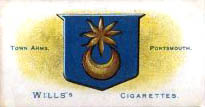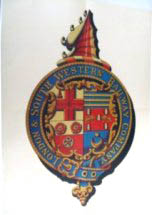Duygu haftaya burada :
Portsmouth (pronounced "ports-muth" and nick-named "Pompey") is a large city in the county of Hampshire, on the south coast of England. Historically, Portsmouth plays a major role in British Naval History and British History in general. The rich historical heritage in the City offers a variety of activities to the visitor such as the Historical Dockyard which houses some of the most historical warships in the world, HMS Victory, which was Lord Nelsons flagship used at the Battle of Trafalgar in 1805 and the Mary Rose, a Tudor-era warship. The City also offers excellent shopping facilities located in the Gunwharf Quays complex home to a variety of designer stores including Ralph Lauren, Hugo Boss and Barbour as well as the striking 557ft landmark Spinnaker Tower from which excellent views of the Solent and City can be viewed. Portsmouth also has two cathedrals including the 831 year old Romanesque-style Portsmouth Cathedral, twelve museums most of which are free and two theaters offering plenty of other attractions of which to visit.
Aside from its rich Naval Heritage, Portsmouth is also known for it's literary history as the birthplace of Charles Dickens, the famous Victorian era novelist and the pioneering engineer Isambard Kingdom Brunel. Other famous figures to have lived in Portsmouth are H.G. Wells, Arthur Conan Doyle the author who created Sherlock Holmes and Rudyard Kipling. Musically, the city is well served by three musical venues The Wedgewood Rooms, Guildhall and Pyramids which regularly host major musical and comedy acts.
http://wikitravel.org/en/Portsmouth#b
The City of Portsmouth has a population of 197,700 and is the only city in England with a greater population density (4,639 /km2(12,010 /sq mi)) than London (4,562 /km2 (11,820 /sq mi)).
http://en.wikipedia.org/wiki/Portsmouth




PORTSMOUTH Futbol Takımının Amblemi ve İlginç Bir Yazı :
STAR AND CRESCENT, PORTSMOUTH.
Constantinople
 The star and crescent symbol was originally used as the flag of Constantinople.
The star and crescent symbol was originally used as the flag of Constantinople.According to legend in 339 BC the city of Byzantium, (later known as Constantinople and then Istanbul), won a decisive battle under a brilliant waxing moon which they attributed to their patron Goddess Artemis (Diana in Roman mythology) whose symbol was the crescent moon.
In honor of Artemis the citizens adopted the crescent moon as their symbol.
When the city became the Christian Roman Constantinople in 330 AD, Constantine also added the Virgin Mary's star on the flag.
Isaac Comnenus of Cyprus
 Isaac Comnenus was the last ruler of Cyprus before the Frankish conquest during the Third Crusade.
Isaac Comnenus was the last ruler of Cyprus before the Frankish conquest during the Third Crusade.He was a minor member of the Comnenus family, a great nephew of the Byzantine Emperor Manuel I Comnenus (1143-1180) and a grandson of the Sebastocrator Isaac.
The coat of arms used by Issac Comnenus was a crescent moon and an eight pointed star on an azure background, adopted in relation with his family links to the Byzantine emperor.
Emperor Manuel made Isaac governor of Isauria and the town of Tarsus in present-day eastern Turkey, where he started a war with the Armenians and was imprisoned by them.
When Isaac was released in 1185, he hired a troop of mercenaries and sailed to Cyprus. He presented falsified imperial letters that ordered the local administration to obey him in everything and established himself as ruler of the island.
Richard the Lionheart
In 1192 the fiancée and the sister of the English King Richard I Lionheart were shipwrecked on Cyprus and were taken captive by Isaac. In retaliation Richard conquered the island while on his way to Tyre.
Isaac was taken prisoner near Cape St. Andreas on the Karpass Peninsula, the northernmost tip of the island. According to tradition, Richard had promised Isaac not to put him into irons, so he kept him prisoner in chains of silver. At this time Richard adopted the star and crescent symbol, which Issac Comnenus had been using, as his own.
Isaac was turned over to the Knights of St. John, who kept him imprisoned in Margat near Tripoli until he was released in c. 1194.
Isaac was taken prisoner near Cape St. Andreas on the Karpass Peninsula, the northernmost tip of the island. According to tradition, Richard had promised Isaac not to put him into irons, so he kept him prisoner in chains of silver. At this time Richard adopted the star and crescent symbol, which Issac Comnenus had been using, as his own.
Isaac was turned over to the Knights of St. John, who kept him imprisoned in Margat near Tripoli until he was released in c. 1194.
Portsmouth Coat of Arms
In 1194 it was King Richard I, Richard the Lionheart, who granted the Town of Portsmouth its first charter.
The star and crescent symbol is also present on the seal of William de Longchamp, Bishop of Ely, who as Lord Chancellor, was involved in the in the granting of Portsmouth's charter.
It is believed that the Town of Portsmouth adapted the symbol to use as its coat of arms in tribute to King Richard, for his patronage in granting Town status.
The Star and Crescent symbol is known to have been used by Mayors of Portsmouth from at least the seventeenth century and probably earlier from the middle ages.
The motto 'Heaven's Light Our Guide' was incorporated into the coat of arms in 1929, it is the same motto that was also used by the Order of the Star of India and was used on Indian troopships which regularly travelled between Portsmouth and the East.
The star and crescent symbol is also present on the seal of William de Longchamp, Bishop of Ely, who as Lord Chancellor, was involved in the in the granting of Portsmouth's charter.
It is believed that the Town of Portsmouth adapted the symbol to use as its coat of arms in tribute to King Richard, for his patronage in granting Town status.
The Star and Crescent symbol is known to have been used by Mayors of Portsmouth from at least the seventeenth century and probably earlier from the middle ages.
The motto 'Heaven's Light Our Guide' was incorporated into the coat of arms in 1929, it is the same motto that was also used by the Order of the Star of India and was used on Indian troopships which regularly travelled between Portsmouth and the East.
Cigarette card.
 This cigarette card shows an example of the Star and Crescent as used in the Portsmouth Town Arms. It was was published by the Wills company in 1903 and is part of their series titled Borough Arms.
This cigarette card shows an example of the Star and Crescent as used in the Portsmouth Town Arms. It was was published by the Wills company in 1903 and is part of their series titled Borough Arms.The text on the reverse of the card reads,
"An eight rayed star, or "estoile", within a crescent. The design recalls the national flag of Turkey, and the badge adopted by Richard I, John and Henry III at the time of the Crusades.
 It is quartered on the arms of the London and South Western Railway Company."
It is quartered on the arms of the London and South Western Railway Company."The arms of the London and South Western Railway Company can be seen on the badge to the right, the Portsmouth coat of arms is shown in the lower, right hand quarter, directly next to the Southampton Coat of Arms, also served by the L&SWR.
The L&SWR began as a railway to link Southampton and London, but over time expanded further to provide services to towns such as Exeter, Plymouth, Ilfracombe, Bude and Padstow.
During this expansion it acquired or leased many other smaller railway companies, in 1923 the L&SWR was itself taken over and became part of the Southern Railway.